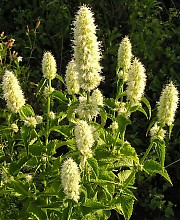Anise-scented nettle
| Anise-scented nettle | ||||||||||||
|---|---|---|---|---|---|---|---|---|---|---|---|---|

Aniseed nettle ( Agastache foeniculum ) |
||||||||||||
| Systematics | ||||||||||||
|
||||||||||||
| Scientific name | ||||||||||||
| Agastache foeniculum | ||||||||||||
| ( Pursh ) Kuntze |
The anise-scented nettle or anise Riesenysop ( Agastache foeniculum ) is a plant of the genus fragrance nettles ( Agastache ) within the family of Labiatae (Lamiaceae).
description
Vegetative characteristics
The aniseed nettle is a perennial herbaceous plant that reaches heights of 60 to 150 centimeters. The upright, square, light green stem sometimes branches in the upper area and is hairy bald to finely downy.
The opposite arranged leaves are divided into a petiole and a leaf blade. The leaves smell of anise (hence the common names ). The petiole is relatively short with a length of 0.5 to 2 centimeters. The simple leaf blade is heart-shaped to broadly lanceolate. The leaf margin is crenate to serrated. The underside of the leaf is white to white-gray and has fine, dense and close-fitting hairs. The base of the blades is rounded or truncated, the lower leaves are weakly heart-shaped.
Generative characteristics
The flowering period extends from July to September. The bracts are ovate.
The number of chromosomes is 2n = 18.
Occurrence
Agastache foeniculum comes in north central North America in prairies before. The range extends from Canada to the northwest and north-central United States.
Taxonomy
Synonyms for Agastache foeniculum ( Pursh ) Kuntze are, for example: Agastache anethiodora (Nutt.) Britton , Agastache anisata hort.
use
Originally used by Indians as a fodder and medicinal plant, it was introduced into Europe as a fodder plant for bees. The fresh leaves of the plant are ideal for preparing salads and liqueurs. In naturopathy, the scented nettle is used because of its anti-inflammatory and digestive effects. The dried leaves from which a tea is made are used.
Agastache foeniculum is rarely used as an ornamental plant for summer borders . It is usually cultivated as an annual.
Individual evidence
- ↑ a b c d e f g Agastache . In: Eckehart Jäger , Friedrich Ebel, Peter Hanelt, Gerd K. Müller (Ed.): Rothmaler - Exkursionsflora von Deutschland . Herbaceous ornamental and useful plants. tape 5 . Spectrum Academic Publishing House, Berlin Heidelberg 2008, ISBN 978-3-8274-0918-8 .
- ↑ a b c data sheet at Illinois Wildflowers .
- ↑ Agastache foeniculum at Tropicos.org. In: IPCN Chromosome Reports . Missouri Botanical Garden, St. Louis
- ↑ Rafaël Govaerts (ed.): Agastache foeniculum. In: World Checklist of Selected Plant Families (WCSP) - The Board of Trustees of the Royal Botanic Gardens, Kew . Retrieved September 18, 2019.
- ↑ Hans W. Kothe: Lexicon of Herbs Everything worth knowing about herbs from A to Z. Komet Verlag GmbH, 2004, ISBN 978-3-89836-406-5 .
